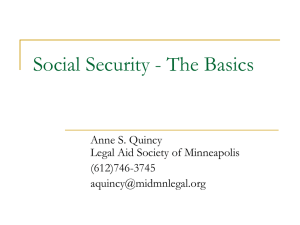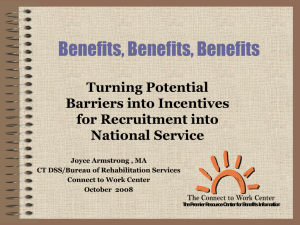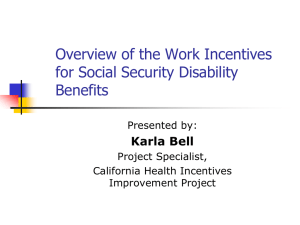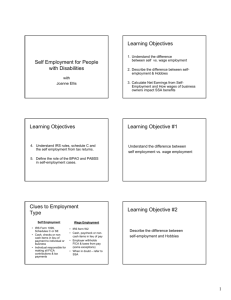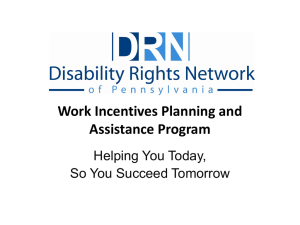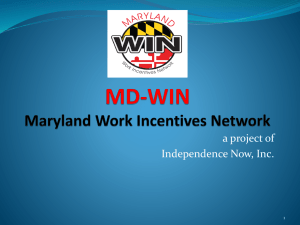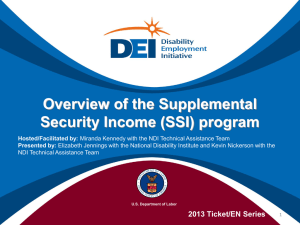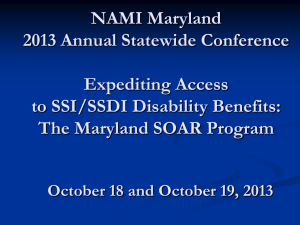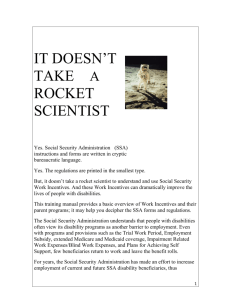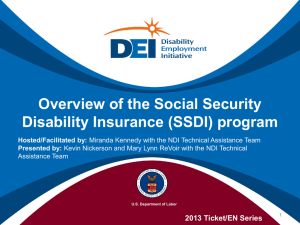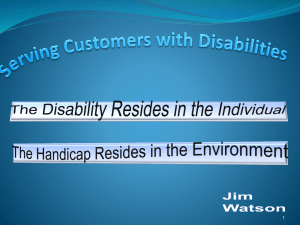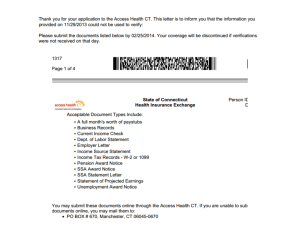Toolbox for Employment - Statewide Independent Living Council of
advertisement
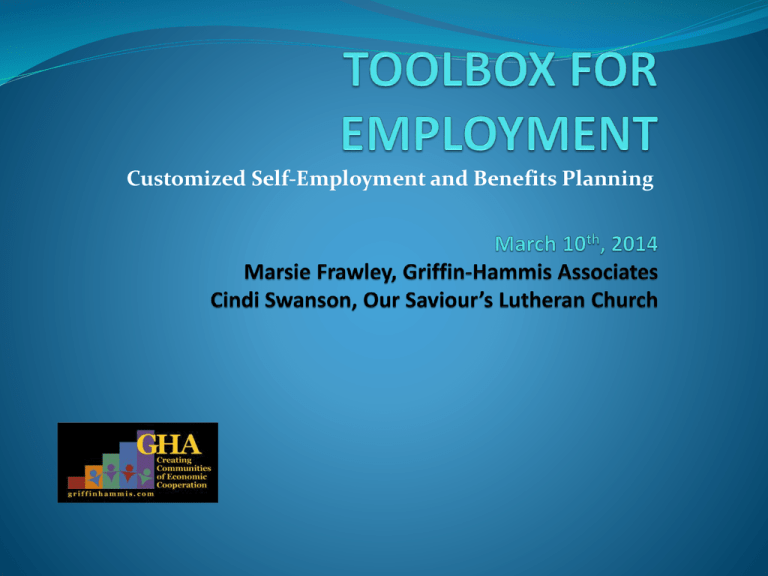
Customized Self-Employment and Benefits Planning Someone You Should Know Having a Vision and Building Social Capital Life begins with a vision Dream BIG Dreams! A lifelong dream with goals = Reality! We want to avoid your child having to live someone else’s program Social Capital To increase the employment of individuals with disabilities by encouraging the use of local contacts through friendships, relationships, business contacts and places Social Capital Focuses on: Who knows Whom (Social Networks) The Character of these Networks The Strength of our Ties Levels of Trust Levels of Reciprocity Knack, S. (2001); Sander & Lowney, (2006) CS My Circle of Friends Intro to Social Capital Trust Growing Elements: Repeated exposure & shared spaces Honesty in Communications Follow-Through on Commitments Consistency in CS Behavior Knack, S. (2001); Sander & Lowney, (2006); Griffin-Hammis Associates Types of Social Capital Public-Regard: we are tied to formal groups (City Council; PTA; People First; Kiwanis) Private Regard: we are tied to informal groups (Church; Softball team; Neighborhood Watch) Formal vs. Informal (Bylaws & Committees Sander & Lowney; Griffin-Hammis Associates CS Types of Social Capital Bridging: Social ties that attempt to cut across differences including Race, Gender, Disability, Class, Religion… Bonding: Links people together like themselves (special interest groups, neighborhood associations, Sander & Lowney; Griffin-Hammis Associates CS Goal of Social Capital Raising Social Capital to improve one’s standing in a community (e.g. using bridging capital to increase awareness of disability access issues in a community) Targeted at Specific Problem-Solving (e.g. using bonding capital to connect a job Sander seeker & Lowney; Griffin-Hammis Associates with someone with CS Relationship Continuum Relationship Continuum Continuum of Growing Acceptance The Relationship Continuum is a visual tool describing the journey humans travel from rejection towards celebrating others. The first step away from rejection is tolerance. The journey continues through acceptance into the Dramatic stage. The Dramatic stage represents acting out the “right” thing to do. In this stage the person does not quite embrace and celebrate the entire person, but their actions represent someone who celebrates another. True celebration is a place we visit once in a while, sometimes only for brief moments. In the best relationship we strive for celebration but often find ourselves at a different level of the relationship continuum. We are blessed if we can truly celebrate the unique gifted individuals in our lives. Along the journey in relationships we need to recognize that the process is a difficult one and it is necessary to identify and let go of the road blocks that stop us along the way. It is important to focus on uncovering the giftedness in others sharing those gifts and being supported as we journey towards celebrating the individual as a valued person in our community. ©PATHFINDERS Consulting Services, Inc. 1998 Layout & Description Original author unknown Goals for Today’s Session Introduction to Social Capital Introduction to Customized Employment and possible outcome of Self -Employment Individuals with disabilities CAN work AND still be connected to the SSI or SSDI cash benefits AND will very likely not lose their health insurance. Goal of Employment Customized Employment –results in either labor market or self-employment based on the strengths and dreams of an individual and the unmet needs of a local market while incorporating the individualized planning and support strategies needed for success. Discovering Personal Genius ™ Benefits Planning – understanding interaction between employment income and public benefits Identification of 3 Vocational Themes ™ Identification of Ideal Conditions for Employment Profile Development Employment Planning and Identification of 20 Businesses Informational Interviews Job Development and Negotiation Ongoing support and career development Exploring the Business Idea(s) Profile development should lead to the identification of one or more interest areas or business ideas Identification of Vocational Themes ™ This does not signal the end of Discovery - “Going Where the Idea Makes Sense” Griffin-Hammis Associates, LLC Profile information guides organic business development process Business concepts can have thousands of iterations – avoid jumping on the very first one Utilize networks and Outcomes of Customized Employment Wage Employment Job Carving Resource Ownership (mix of wage and self-employment) Self-Employment Business within a Business Home-Based Community-Based Why Self Employment? Business Need in Community Can be met by individual who, for a variety of reasons, may not be as successful in wage employment Allows for schedule needs – slower in morning after sleepless nights Medication schedules Identifying Business Concepts Person-Centered Planning Discovery Business Owner Profile Discovering Personal Genius The ideal Conditions of Employment Strengths, Interests, Supports, Contributions Relationships that matter and that help us get lots of Business Within a Business Business operates as its own entity within another organization (no overhead, co-located in another business) Built-in support and customer base may readily exist Can be a unique and interesting option for potential entrepreneurs Resource ownership vs. Meet Bryan of Canton, IL. CuBBull, Inc. Loves quarters; sports and fire departments His passions led to the development of a business – which employed Brian – CuBBull, Inc. provided vending machines at local fire departments Now 20 businesses have vending machines around the county Brian is also employed at a Determining Feasibility Discovery of individual leads to interest areas, ideal conditions, and possible industry / connections Discovery of community leads to specific potential iterations for business products Determining Feasibility (continued) Not writing the plan Researching major aspects of business idea Running basic numbers Conducting market research Information ultimately goes into the plan Keep good notes!!! Benefits of SelfEmployment Process begins whenever individual is ready – no lengthy job search process Businesses are grown specifically around individual Talents, skills, interests, etc. Necessary accommodations written More Benefits of Self-Employment Potential for greater financial rewards Way to break out of the “minimum-wage / not enough hours” trap Opportunity to be the boss from the start Disability benefit programs offer unique financial incentives to business owners What Does it Take? Desire to run and grow a business Team of people willing to support the process (formally and informally) Patient, systematic, thorough research and planning process Willingness to revise and learn as you go Commitment to develop accommodations as necessary All of these can be on the part of the support people who What It Doesn’t Take Arbitrary academic or skill levels Entrepreneurial Attitude and/or Know How Ability to perform any/all business functions 100% independently Previous established success in wage employment and / or industry Person should be integrally Choose NOT to Pursue SelfEmployment? Range of support need exceeds what is available (both natural and professional supports) No market for the product of service or product exists at the current time Everyone Needs a Wilson From Tom Hanks in “The Castaway” . . . Enlist support! Team process is critical! Business Development Team members should include: Circle of Support members (e.g., family members, friends, paid providers) Community business resources: SCORE, SBDC, etc. (no need to recreate the wheel!) CWIC’s and/or other SSA supports SERN Business Mentor through Division of Rehabilitation Services Other people you meet along the Numbers Talk, Poverty Walks Ultimately, all businesses have to pass the profitability test Businesses that don’t make money are hobbies Be “tough on ideas, easy on people” In the words of my late friend and mentor . . . “Why start a business where you PLAN to lose money?” David G. Hammis Steps to SelfEmployment Identify Business Concept Assess Feasibility Develop Business Plan Develop Resource Plan Secure Funding Launch! Business Planning Need to develop a plan – work with experts Need to determine business structure Sole Proprietorships Partnerships Limited Liability Companies Corporations A corporation requires that employees (even the owner) be paid a wage – which eliminates SSI eligibility Sole Proprietorship can lead to maintenance of public benefits, but The 3 C’s of Business Customers – determining target market Competition – identifies strengths and weaknesses; if you can’t beat them – join them! – collaboration vs competition Capabilities – How much Considerations Important to understand how the business may impact public benefits SSA looks at self employment differently than wage employment Parents own/run the corporation and from which the individual works for and is paid Important to be aware of local, state and federal licenses business laws How to Begin Pursuing Self Employment Identify interests and ideal conditions for employment Determine PASSION and find a way to put a value to a service or item! Develop the business concept and business evolves! Benefits of starting before exiting the school system: – Include in IEP and Transition Plans – Get started with the support of school system i.e., speech, Making Self Employment a Reality - Partnerships Work Incentives Planning & Assistance Projects www.iltech.org/wipa.html Small Business Development Centers http://www.commerce.state.il. us/dceo/Bureaus/Entrepreneu rship+and+Small+Business/SBD C.htm SERN – Self Employment Resource Network First Friday Entrepreneur’s Business AND Benefits Planning Go hand in hand Starts with Discovery–DPG™ Have to understand the interaction of income from wage and/or self-employment on public benefit systems What public benefit systems are being received now? SSA, Medicaid, DD Waivers – CILA? Home Based Support?, DRS Home Services Show of Hands! I think these benefits programs are……. A. Easy to Understand B. Challenging to Understand, but not Rocket Science. C. Rocket Science. Two Disability Cash Programs Supplemental Security Income (SSI) Strict income and resource limits No work history required $721 - 2014 Federal Benefit Rate Social Security Disability Insurance (SSDI) Based on work record No income or asset limits Supplemental Security Income o 2014 SSI Amount $721 ($1,082 for a couple) Payment can vary based on living arrangements and other factors o Not guaranteed to always receive the full amount o o $2,000 – Asset and Resources Limit each month o If qualify for SSI, probably also for Medicaid Social Security Disability Insurance CDB • • Childhood Disability Beneficiary Adults (18 and older) having a disability determination before age 22 can collect SSDI on their parents Social Security employment earnings record, if the parent: • Becomes retired and collects SSA • Becomes disabled themselves and collects SSDI • Becomes deceased CDB becomes eligible for Social Security Disability Insurance – On Own Record oAn individual with a developmental disability from birth can be found eligible for their own SSDI after 6 work credits are earned o2014 – one Social Security Credit earned = $1,200 gross o2014 – up to four credits earned = $4,800 24 months after being found SSI Work Incentives o o o o o Student Earned Income Exclusion PASS Plan Earned Income Exclusion Impairment Related Work Expenses 1619 Student Earned Income Exclusion Under age 22 and in school High School Community College Trade School SSA will exclude up to $1,750 of earned income per month, up to an annual exclusion of $7,060 Note: For Recipients of SSI, not dependent SSDI students! Have to provide verification to SSA of Plan for Achieving Self Support PASS allows you to set aside income and/or resources for a specified time for a work goal. For example: set aside money to pay expenses for education, vocational training, or starting a business as long as the expenses are related to achieving a work goal. o The money in this plan will not count as an asset for SSI, Medicaid or most public PASS Specialist (Cadre) Karl Gillespie 866-575-4889 (Toll-free) 312-575-6505 (Local) 312 575 6501 (Fax) karl.gillespie@ssa.gov Mail completed PASS applications to: SSA/PASS Cadre 600 W. Madison, 5th Floor Chicago, IL 60661 Supplemental Security Income and Earned Income Calculation SSI and earnings are calculated with a formula. These deductions are subtracted from the gross income to determine countable income: General Income Disregard $20.00 Student Earned Income Exclusion Earned Income Disregard $65.00 Impairment Related Work What on Earth Does All That Mean? When a recipient of Supplemental Security Income is working and gross earnings are above $85 – there WILL be an impact on the monthly SSI cash benefit Will the SSI check go down – YES, unless Student Earned Income Exclusion, IRWE’s or PASS reduce countable benefits to below $85 Is this a bad thing? Medicaid - 1619 1619(a) – When gross earnings are over $1,070/month in 2014 – free Medicaid 1619(b) – When gross earnings are over $1,527 (or when SSI check goes to $0 from Earned Income ($721 x 2 + $85 – Called the ‘Breakeven’) Keep Medicaid until annual earnings of $27,811 in 2013 (2014 to be announced!) SSDI and/or Childhood Disability Beneficiary (DAC) Trial Work Period (TWP) (2013) $770 (2014) $750 Extended Period of Eligibility (EPE) Substantial Gainful Activity (non-blind SGA) $1,040 (2013) and $1,070 (2014) –These amounts change annually Blind SGA $1740 (2013) and $1,800 (2014) Grace Period Impairment Related Work Expense (IRWE) Subsidies and IRWE’s Can be used in determining eligibility, as work incentives to reduce countable income and in overpayment cases! Subsidy – only SSDI When accommodations are provided by the employer to allow the worker to be paid what co-workers without disabilities are paid IRWE’s – both SSI and SSDI Expenses paid out of pocket by the beneficiary who needs the item in order to work; ie, medications, Work Incentives for Self-Employment SSA refers to an individual as self-employed if the individual is paid through a 1099 (SelfContractor) or they have a tax number. SSA accepts what the IRS accepts as net income from selfcontracting or self-employment. NOTE: If the individual's business is incorporated, they receive wages, not self-employment earnings. Under Self-Employment instead Countable Earnings in Self-Employment Net earnings from selfemployment (NESE). Gross receipts from the business. Minus business expenses. Minus a .9235 exclusion for FICA after 12/31/89. (100% - 7.65% = 92.35 or 0.9235) Minus applicable work incentive deductions. SSI: Self-Employment and PASS PASS submission must include a business plan. Work with SBDC, SCORE, DRS to develop the plan to accompany the SSA form Introducing Devora Frames By Devora Shows she is happy by waving her hands Demonstrates a passion in ‘painting’ and making a mess! Her mother developed that passion into a marketable item – hand-painted frames Funded through DRS, Life My Way grant and SSA – PASS – reducing dependence upon SSI! Devora actively shops for frames; delivers frames; takes SSDI: Average Monthly Income If payment is not received in every month in which work is performed, income for the entire work period is averaged: Farmers are paid after harvest – average income over the months the work is done. Writers are paid when a book/article is published – average income over months SSDI: Unpaid Help Reasonable value (prevailing wage) of any significant amount of help furnished by spouse, children, or others unpaid. Name of individual(s) providing help and relationship to beneficiary. Reason for unpaid help. Description of services, time spent, length of time arrangement lasted. SSDI: Unincurred Business Expense Paid for by someone other than the beneficiary, i.e. DRS May be no actual expense incurred and paid by anyone. For example: Includes use of space in a government building, or items Other Considerations When individuals works and pay into FICA taxes, credits are earned toward Social Security Administration benefits One credit is = $1,200 in gross earnings (2014) A maximum of 4 credits annually = $4,800 (2014) 6 credits earned under the age of 24 affords eligibility for SSDI 24 months later become eligible for Medicare Meet Brian M. of Northbrook Hardback YoYo Self-Employment takes a team! At 18 years old - loves books and keeping the earth a great place for all to live, Brian was inspired to create an eco-friendly business – springing old books into a new purpose. Taking products that would have been discarded and otherwise considered useless and turn them into a new UPCYCLED product. Hardback YoYo is called a minimicroenterprise due to Brian’s being a student (first in high school and now at community college), as well as, an entrepreneur. Being self-employed, he relies on the help and support of others. SSDI and Medicaid Medicaid income limit as of January 2013 = $931/monthly If work income is above that level, Healthcare and Family Services calculates a spenddown Spenddown is essentially a deductible of medical expenses are incurred (doctor co-pays, Community and Home Based Services) Medicaid: Health Benefits for Workers with Disabilities Workers with Disabilities - age 16 to under 65 Pay small monthly premium (avg: $40 - $50) Proof of paying FICA taxes (no minimum) Earnings to $3,258 / month – NET ($39,095) Savings up to $25,000 Retirement Accounts are not counted! Introducing Joseph/Joe Poppin’ Joe’s Kettle Korn In high school – described as combative; non-communicative Parents recognized that labor market employment would not work for ‘Joe’ Joe loves people; being out-ofdoors; making noise Started out with a ‘popcorn stand’ outside of Wal-Mart Today, Joe lives in his own home with supports; the company has gross earnings over $75,000; has several part- Funding Self Employment Illinois Assistive Technology Program Cash Loan Program http://www.iltech.org/cashl oan.html Division of Rehabilitation Services http://www.dhs.state.il.us/of ficelocator Social Security Administration – Plan for Achieving Self Support Examples Helper Girl (loves to be on the move) http://www.jjslist.com/pages/bridg e_builder_detail/28.php?id=519 CuBBull (loves quarters) Frames By Devora (loves to paint) www.framesbydevora.com Hardback Yo-Yo (loves old books and ‘upcycling’) www.hardbackyoyo.com Poppin’ Joe’s Kettle Korn (loves people, noise, movement) http://poppinjoes.com/ Shredigator Resources Griffin-Hammis Associates www.griffinhammis.com Online Training: http://griffinhammis.ce quick.com/ Department of LaborOffice of Disability Employment Policy www.dol.gov/odep Work Incentives Planning & Assistance Projects Resources Continued Rural Institute of Montana Self – Employment Project http://rtc.ruralinstitute.umt.edu/?pag e_id=5028 Self Employment Resource Network www.sernonline.net Start-Up USA http://www.start-upusa.biz/resources/listContent.cfm?f ormatID=2 Questions THANK YOU!!! For Sponsoring this complimentary workshop! SILC of Illinois; Clearbrook; College of Lake County; The Institute on Public Policy for People with Disabilities Contact Information Marsie Frawley Senior Consultant Griffin-Hammis Associates, LLC 920-559-6364 mfrawley@griffinhammis .com www.griffinhammis.com Contact Information Cindi Swanson Disabilities Ministry Coordinator – Our Saviours Lutheran Church Naperville, IL (630) 947-3582 cbswanson@juno.com
